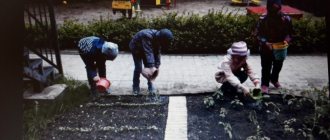Planting flowers
Prepared by teacher: Olga Borisovna Egorenko
MBDOU DS No. 53 “Fairy Tale”, Chelyabinsk region, Ozersk city
Summary of GCD in the middle group “Planting flowers from seeds”
Educational field: Cognitive development (experimental activities).
Integration of educational areas: “Cognition”, “Communication”, “Socialization”, “Labor”.
Types of children's activities: cognitive-research, communicative, play, work.
Target:
Development of children's ideas about the life of a plant, its reproduction, structure.
Tasks:
1. Expand children’s understanding of flowers and how to reproduce them. Give children the opportunity to put into practice their acquired knowledge about growing (reproducing) flowers.
2. Activate children’s speech activity, exercise the ability to form nouns with diminutive suffixes, construct complex sentences, and practically use the preposition U. Develop auditory attention, memory, thinking, fine motor skills, coordination of speech with movement.
3. Develop a caring attitude towards the surrounding nature, a desire to grow a plant from seeds yourself. To instill in children neatness when doing work, to teach them to put the equipment they use in order after finishing work.
Preliminary work:
Conversations about plants, looking at illustrations of flowers, reading poems about spring flowers, practical activities - planting onions, creating parcels, letters.
Equipment:
A poster depicting a variety of flowers, a “magic bag”, containers for planting seeds with soil, watering cans with water, sticks for loosening the soil, flower seeds, aprons and cups according to the number of children, oilcloth, a picture of a part of a flower, a diagram of planting seeds, items for the game “Choose what you need”, “Magic bag”.
Progress of the lesson:
(Knock on the door) - Someone's knocking, guys! Who could it be? I'll go and have a look. They sent us a letter and a parcel (the children are standing around me).
Who sent this to us? Let's find out what they write to us.
I read the letter:
“Hello, dear guys from group 8. We residents of the “Flower City” love flowers very much. There are a lot of them growing in our magical city. They are different, but all very beautiful. We know that you are hardworking guys and love flowers. And that’s why we want to give you a gift. And you will receive it if you complete our tasks."
-Do you guys want to receive a gift? Then try your best.
Exercise 1
guess the name of the flower
| Puzzles | Teacher's explanation |
| Breaking through the snow Amazing sprout. The very first, the most tender, The whitest flower! (Snowdrop) Rose, find and place this flower. | Guys, who knows a poem about this flower? (read by Arina) |
Timing for sowing vegetable seeds in open ground
All spring crops of vegetables in open ground garden beds are conventionally divided into 3 groups. When and what to plant in the ground in Siberia:
Early spring sowings (from March 16 to April 15)
This group includes crops that do not have high lighting requirements. Sowing of greens and some vegetables is carried out in stages, every 10-16 days, in order to extend the period of fresh harvest.
List of crops that can be planted in Siberia at +4 degrees in a ten-centimeter layer of soil:
Vegetable plants related to green and spicy flavors:
- celery;
- dill;
- mustard;
- coriander;
- fennel;
- parsnip;
- asparagus;
- parsley;
- Melissa.
Leafy vegetables that form an above-ground crop:
- early cauliflower;
- salad;
- spinach;
- peas;
- rhubarb;
- broccoli;
- horseradish;
- early white cabbage.
Bulbs and root vegetables:
- onion sets;
- early carrots;
- turnip;
- swede;
- radish;
- radish;
- nigella onion.
Mid-spring crops (from April 16 to May 20)
The sowing date for vegetables is also adjusted by spring weather. In a chilly and wet spring, it is usually moved a week later. Crops belonging to this group are also sown in stages, every 10-16 days, in order to organize a conveyor supply of fresh products.
After waiting until the soil in the root zone warms up to +5 degrees or more, you can begin to sow:
Green vegetable plants:
- chicory;
- leaf type celery;
- celery root.
Other vegetables:
- medium white cabbage;
- beans;
- savoy cabbage;
- onion sets;
- leek;
- early and medium potatoes;
- Kohlrabi cabbage;
- spring garlic;
- Brussels sprouts;
- beans;
- red cabbage;
- vegetable corn;
- medium carrots;
- beet.
Late spring sowing (from May 21 to June 15)
Sowing of such crops begins when stable warm weather has established and the threat of recurrent night frosts has passed. In Siberia, this happens at the start of the second ten days of June. At this point, the soil in the root layer is heated to +12..17 degrees.
During this period of time, the following crops are planted in the Siberian regions:
- tomatoes;
- zucchini;
- beans;
- cucumber;
- basil;
- pepper;
- marjoram;
- eggplant;
- melon;
- pumpkin;
- watermelon.
Attention! If there is a goal to shift the sowing date of certain crops to an earlier date, it is necessary to insulate the beds and build shelters.
What varieties of tomatoes are sown for seedlings in January
Most often, when starting tomato cultivation in January, preference is given to late-ripening tomato varieties. They are characterized by a long growing season, slow growth and late fruiting.
MOST READ FROM PARTNERS
This choice, among other things, is due to the fact that by the time the seedlings are transplanted into an open bed, they will have fully developed, so the adaptation period will pass quickly and unnoticed.
Preference is given to varieties:
- Bull's Heart;
- Russian size;
- Altaic;
- Sugar giant.
If you have a heated greenhouse or greenhouse, it is allowed to sow early ripening varieties, then the harvest can be harvested 90 days after planting. Early ripening tomatoes include:
- Maksimka;
- Sanka;
- Far North;
- Lyana.
ATTENTION! When sowing in winter, seed germination is much worse. It must be pre-prepared: soak in a solution that stimulates growth. The products Epin and Zircon have proven themselves well.
Features of sowing tomatoes for seedlings in January
It is necessary to prepare in advance for winter planting. It is necessary to sow tomatoes in January taking into account certain rules. First you need to tackle the soil. You can prepare the soil yourself from the following components:
- turf land - 1 part;
- garden soil - 1 part;
- peat – 4 parts;
- mullein – ¼ part.
MOST READ FROM PARTNERS
It is important to pre-heat the soil or freeze it well, this will help disinfect the substrate.
ON A NOTE. If you do not want to prepare the substrate yourself, you can buy a ready-made one in the store. It’s called “for seedlings”.
Afterwards, the soil is poured into a common container or plastic cups or other containers. In the first case, it is necessary to make grooves, their depth should be about 1 cm. A distance of 2 - 3 cm is left between them.
Seeds are placed in the holes, lightly sprinkled and moistened. Afterwards, the containers are covered with film and put away in a warm place until shoots appear.
Plants for landscaping and decoration
When choosing plants for a children's room and preschool institutions, first of all you should pay attention to their phytoncidal properties. Such plants are capable of producing biologically active substances that help fight harmful microorganisms and suppress their development.
Plants decorate and benefit
As a result of research, it has been proven that in rooms with plants with phytoncidal properties located in them, there are 50% fewer pathogenic organisms than in similar rooms without flowers.
With the right selection of indoor plants, you can restore the body's defenses and increase immunity in half an hour.
Aspidistra
Aspidistra An unpretentious plant that does not have a dormant period. Lithuania plants are very beautiful and large. Depending on the species, the elongated leaf blades can be painted pure green or may have blotches of a darker tone scattered over the entire surface.
To obtain new specimens, it is necessary to divide the bush of the mother plant. This method is quite simple and does not require any effort. Planted plants quickly adapt to a new location and quickly begin to grow. It is better to propagate in early spring, when the aspidistra begins its period of active growth. A small section with its own root system and several leaves is separated from the mother plant. At first, the potted plant is kept in a warm, humid room.
Aspidistra with green leaves is unpretentious to light levels, soil composition and soil moisture. The variegated plant is more capricious.
It is advisable to grow the variegated form of aspidistra in a well-lit place, since due to insufficient light the pattern on the foliage may disappear!
Geranium
Geranium A beautifully flowering and strong-smelling plant, it is in second place, after Chlorophytum crested, in terms of the presence of beneficial properties that have a phytoncidal effect.
The plant is considered a very powerful air purifier, enriching it with oxygen.
Geranium leaves are used by traditional healers as a remedy for the treatment of colds and runny nose.
However, the strong smell emanating from geranium foliage can cause an allergic reaction in many, so the plant must be grown with caution. Before breeding in a nursery, you need to make sure that the child is not allergic to it.
Hibiscus
Hibiscus An ornamental evergreen plant has recently gained universal popularity due to its gorgeous flowering, even though the flowers on hibiscus last for exactly a day.
The leaf blades are dark green. A common variety in indoor floriculture blooms with red flowers. Thanks to breeding work, many varieties with different flower colors have been developed: yellow, white, orange. There are even specimens with two-color flowers.
When fully bloomed, the flowers look like roses. The plant likes frequent watering and fertilization.
Due to its large size, it is recommended to curb the growth of hibiscus by pruning. However, you need to do this carefully, because every time you shorten the branches of a plant, you can lose its flowering.
For propagation, slightly lignified cuttings are used, which easily take root both in water and immediately in the ground.
Hippeastrum
Hippeastrum An ideal plant for children's rooms and preschools. The vegetative part of the hippeastrum releases substances into the air that have a detrimental effect on bacteria and viruses.
Like no other plant, hippeastrum contains alkaloids - useful substances and compounds that have a positive effect on the nervous system.
Recommended for the owner of the room who tosses and turns for a long time and cannot sleep. Heppeastrum acts on a subconscious level and improves children's sleep. Recommended for hyperactive children.
Fragrant herbs
Fragrant herbs Together with overly active and restless children, it is necessary to grow fragrant herbs. Many pediatricians advise placing a small flowerpot with peppermint, lavender and lemon balm in the room. This composition can be confidently called a living analogue of an aroma lamp.
And when the kids grow up, they can independently pinch off a couple of leaves of healthy fragrant herbs from their garden and add them to tea.
It is necessary to give the child complete independence in caring for his impromptu garden.
A composition of fragrant herbs will fill the air with soothing aromas, create a warm, relaxing atmosphere and cleanse the air of harmful impurities.
And herbs reproduce very easily - by seeds. You can rejuvenate the bushes and plant new plants from time to time.
Kalanchoe
Kalanchoe This is a plant that must be grown in a nursery or in a house where children's voices are heard.
Kalanchoe has powerful phytoncidal properties. By growing a plant on the windowsill, you provide yourself and your family with the necessary medicines that are harmless to the body and have an effective effect on colds and respiratory diseases.
Rubbing a Kalanchoe leaf can cure a runny nose in a matter of days, which cannot be said about the effect of medications that may not achieve the desired effect.
Arabian coffee
Arabian coffee Under natural conditions, the plant reaches 8-10 m in height. Cultivated species cannot please with such rapid growth, but this is not the most important thing, because when grown at home, not every owner will be able to provide it with so much space.
The bark of the small tree is covered with light green, slightly gray bark. Opposite leaves are located on drooping, flexible branches. The leaf blades are attached to the branches by short petioles.
Green coffee leaves purify the air and enrich it with beneficial substances.
Laurel
Laurel Laurel is a small shrub whose branches are densely covered with dark green foliage. When rubbed, the shiny foliage thins out its unique aroma. Flowering is long lasting. It blooms with small flowers with yellow petals.
Under natural conditions it can be found in the Crimea and the Caucasus. The indoor form of laurel reaches a height of 2 m, and in natural growing conditions the tree grows 6 m in height.
Laurel must be grown, as the foliage releases beneficial substances that destroy bacteria.
In addition, the unusual tree has many other advantages. The substances included in the composition and released into the air have a detrimental effect on the tuberculosis bacillus.
The leaves help treat sore throats and inflammation in the mouth, so it’s not even a sin if a child picks a leaf from a tree and chews it a little. This will not affect the baby's health in any way.
In spring and summer, it is preferable to grow laurel on a balcony or terrace. It is advisable to provide him with a flow of fresh air. And laurel propagates very easily - by cuttings.
Lemon tree or citrus garden
Lemon tree or citrus garden You definitely need to plant some kind of citrus tree. And it doesn’t matter whether this tree is a lemon, a tangerine or an orange, the important thing is that it is very useful for children.
Each of the citrus trees contains essential oil, which has bactericidal properties.
And how beautiful the plant is during flowering! In addition, during flowering, the lemon tree thins out such a wonderful aroma and releases substances into the air that have a calming effect on the nervous system.
Therefore, growing citrus trees is recommended in a nursery owned by an overly impulsive and irritable child. Citrus trees help solve the problem of insomnia.
Many parents are dejected that there is a non-flowering tree growing in the room. There's nothing wrong with that. Not only the fruits and flowers of exotic plants emit beneficial substances; the leaves of the plant are also endowed with similar properties.
If at the moment you want to enjoy the aroma of citrus trees, it is recommended to rub a leaf in your hands and feel this captivating aroma.
Myrtle
Myrtle During flowering, myrtle is covered with numerous snow-white flowers. Its flowering has a calming effect on a person and calms the nervous system. That is why it is recommended to grow myrtle in children's institutions.
The aroma of myrtle can relieve daytime fatigue and help the body recover from stressful situations. It is useful for schoolchildren because it relieves fatigue and stress received during classes.
For very restless children and children suffering from insomnia, myrtle helps improve sleep.
Myrtle aroma relieves severe anxiety, has a relaxing effect, and relieves excessive excitement. It helps insecure children (and adults) to get on their feet and feel confident in their abilities.
Fern
Fern Fern is an evergreen plant with interesting leaves, not even leaves, as we usually call them, but with branches with shoots.
It is recommended to grow ferns in those houses whose owners would like to feel more confident in their abilities.
The plant helps protect against stress. By growing a fern, it will help you not waste your time; it will help you plan your day in such a way as to spend it profitably, leaving time for rest.
Necessary for those who are unable to decide what is most important to them. Fern helps to prioritize and highlight the main things, placing emphasis on them.
Chlorophytum crested
Chlorophytum crested The plant is widespread and is found in almost every gardener's home, educational institutions, and kindergartens. Chlorophytum crested is an unpretentious plant that can purify the air 100%. It is used as a natural filter.
Green or green-white elongated leaves of chlorophytum can cleanse the room of harmful impurities. They have an effect on pathogenic bacteria and viruses.
Scientists have found that in children's rooms where chlorophytums are grown, children are much less likely to get colds and flu.
Chrysanthemum
Chrysanthemum A beautiful flowering plant is a necessary element of children's room decor. The plant not only disinfects the air, but also filters air flows well, freeing them from dust and impurities.
It is recommended to grow plants in every home or garden plot, as it is believed that chrysanthemum growing in the house protects the owner from the evil eye.
Usambara violet
Usambara violet
Uzambara violet A lot can be said about violets. Uzambara violet is the queen among all indoor flowers. Thanks to such high popularity and demand, a huge number of varieties have been bred that delight the eye not only with variegated, multi-colored foliage, but also with huge, simple, double flowers. There are also chimera violets.
If the space is limited, you can collect a large collection of mini-violets. If it is not possible to grow plants, you can buy hanging varieties and grow them in a small hanging pot. Anyone who once has a violet in their home will subsequently not be able to refuse to purchase more and more new varieties.
Violet has a beneficial effect on the nervous system, calms and gives peace. The warm tones of flowers soothe, give a positive mood, and cleanse the air of various negativity and dust. Looking at a bouquet of gorgeous flowers, you can admire them for hours.
Ficus
Ficus This plant was one of the first to be studied by botanists for the effect it has on the atmosphere of the house and human health. During the research, it turned out that the beneficial substances released by the plant into the air purify it of harmful impurities, for example, phenol, formaldehyde, benzene, and trichlorethylene.
Ficus leaves contain enzymes that saturate the air with oxygen. Thanks to them, absorbed harmful substances are converted into amino acids and sugar.
Cyclamen
Cyclamen Plant of creative people. It is recommended to place it in a room with an older child, as cyclamen can awaken hidden creative talents in a child.
The plant helps to find a common language and has a unifying effect, therefore it is recommended for growing in kindergartens and in groups of children.
In addition, children's institutions practice planting chlorophytum curica and cyclamen - two plants that are grown in tandem. As a result of decorating a room with these flowers, the air in the room is noticeably purified and children's creative abilities are revealed, which can be revealed in the process of collective work.
Whatever plants parents choose to decorate the children's room, you must first find out their beneficial properties that they have on children and think about how this or that plant will be useful for the child. In children's institutions, it is recommended to grow plants that are considered safe for children and are approved for growing in institutions.
Lunar calendar for sowing tomatoes in January for every day, table
The table will help you determine the date.
| Number | Zodiac sign | Can you plant it or not? |
| 1 | Sagittarius | The moon is waning. It is not advisable to sow. |
| 2 | Capricorn | New moon. Bad time for sowing. |
| 3 | Capricorn | Growing phase. Bad day for planting seedlings. |
| 4 — 5 | Aquarius | Growing phase. Unlucky zodiac sign for sowing. |
| 6 — 7 | Fish | Growing phase. Does not have any effect on the result of planting work. |
| 8 — 10 | Aries | The moon is waxing. There is no effect on the result of planting work. |
| 11 — 12 | Taurus | The moon is waxing. It's a good time to sow tomato seeds. |
| 13 — 15 | Twins | The moon is waxing. It's a good time to sow tomato seeds. |
| 16 — 17 | Cancer | Growing phase. It's better not to sow. |
| 18 | a lion | Full moon. Prohibition on carrying out planting work. |
| 19 | a lion | Waning phase. Not suitable for starting cultivation. |
| 20 | a lion | The moon is dying. The right day to start sowing tomatoes |
| 21 — 22 | Virgo | Waning phase. It is better not to plant anything during these two days. |
| 23 — 24 | Scales | The moon is dying. There is no effect on the result of planting work. |
| 25 — 26 | Scorpion | Waning phase. Planting is prohibited. |
| 27 — 29 | Sagittarius | Waning phase. It's a good time to sow seedlings. |
| 30 — 31 | Capricorn | The moon is dying. Not suitable for sowing. |
Methods for growing tomatoes that require sowing in January
As mentioned above, sowing seedlings in January is advisable for greenhouse cultivation.
There are two ways to get tomato seedlings.
- The first involves growing in a common box. Soil is poured into the container, moistened, and furrows are made in which to sow. A distance of 2–3 cm is left between the grains. Afterwards, greenhouse conditions for germination are created using a film in which the container is wrapped.
- In the second case, in each cup (peat or plastic, a peat tablet is also suitable) you need to plant 2-3 seeds to a depth of 2 cm. Then the container is also covered with film.
When is it not worth sowing tomatoes for seedlings in January 2022 according to the lunar calendar?
There are times when you should not plant a vegetable crop, since the percentage of seed germination is too low. It is worth refraining from working during the full, new moon, as well as the day before and after the onset of these phases. Bad days are considered to be those when the moon enters the sign of Aquarius.
Using the lunar calendar, you can easily navigate the time that is unfavorable for sowing. In the first month of the year, it is highly undesirable to plant tomatoes 1 - 3, 16 - 19, 21, 22, 25, 26, 30, 31.
When to plant tomatoes for seedlings in January 2022 according to the lunar calendar, favorable days
When choosing a planting date for tomatoes, experts recommend following the lunar calendar.
There are several recommendations on how to properly interact with the calendar:
- activities related to sowing work are carried out strictly on the waxing moon;
- when the moon is waning, planting seeds is carried out in exceptional situations, although it is not contraindicated;
- It is strictly forbidden to plant on the full moon and on the new moon;
- the phase in which the luminary is in the sign of Aquarius is considered an unlucky time;
- During the new moon, it is better to refrain from planting seed material, as well as the day before and after it.
According to the lunar calendar, the most successful time for obtaining tomato seedlings is considered to be from January 4 to January 15, inclusive.
It is also permissible to sow seeds on the dying moon from the 20th to the 30th, but the seedlings will be a little worse.
Caring for tomatoes sown in January
Tomatoes are considered a rather capricious vegetable crop, so they need to be cared for in compliance with certain agrotechnical rules. It is better to familiarize yourself with them before sowing the seeds.
Temperature and lighting
The ideal temperature before sprouts appear is +23 degrees. Afterwards +18+20 degrees will be enough.
Daylight hours should be at least 12 hours; if it is less, then additional lighting should be provided.
Watering and fertilizing
It is necessary to moisten the soil as it dries. It is best to do this with a spray bottle. After emergence of seedlings, water at the roots.
Feeding is carried out once a week. A solution of superphosphate is used as fertilizer. Prepare the product at the rate of 1 tbsp. spoon of component per 5 liters of water.
Picking
MOST READ FROM PARTNERS
All sprouts on which more than two full-fledged leaves have formed are subject to the procedure. This usually happens 2 weeks after sowing. Shoots should be removed with special care to avoid damaging the roots. Deepening into a new container is carried out to the level of the lower leaves.
ON A NOTE. If you sowed the grains directly into separate containers, then there is no need to dive.






